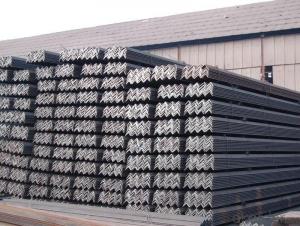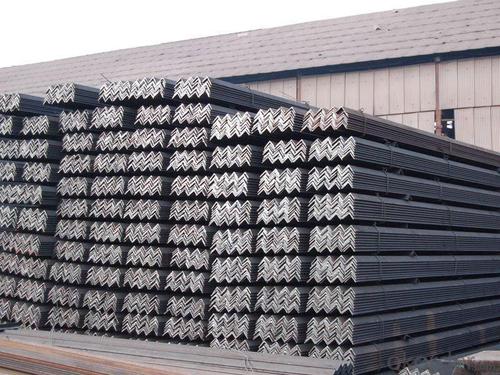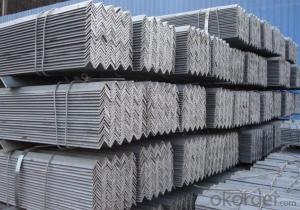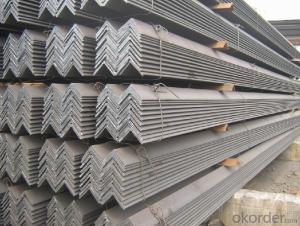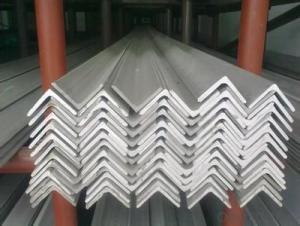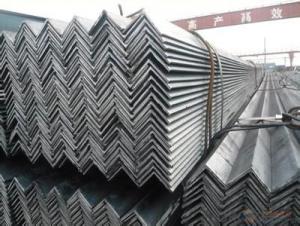Equal Angle Steel High Quality Q235 or ASTM A36 20-250mm
- Loading Port:
- Tianjin
- Payment Terms:
- TT or LC
- Min Order Qty:
- 25 m.t.
- Supply Capability:
- 10000 m.t./month
OKorder Service Pledge
OKorder Financial Service
You Might Also Like
Product Description:
OKorder is offering High Quality Angle Steel Q235 or ASTM A36 20-250mm at great prices with worldwide shipping. Our supplier is a world-class manufacturer of steel, with our products utilized the world over. OKorder annually supplies products to European, North American and Asian markets. We provide quotations within 24 hours of receiving an inquiry and guarantee competitive prices.
Product Applications:
According to the needs of different structures, Angle can compose to different force support component, and also can be the connections between components. It is widely used in various building structures and engineering structures such as roof beams, bridges, transmission towers, hoisting machinery and transport machinery, ships, industrial furnaces, reaction tower, container frame and warehouse etc
Product Advantages:
OKorder's High Quality Angle Steel Q235 or ASTM A36 20-250mm are durable, strong, and resist corrosion.
Main Product Features:
· Premium quality
· Prompt delivery & seaworthy packing (30 days after receiving deposit)
· Corrosion resistance
· Can be recycled and reused
· Mill test certification
· Professional Service
· Competitive pricing
Product Specifications:
Manufacture: Hot rolled
Grade: Q195 – 235
Certificates: ISO, SGS, BV, CIQ
Length: 6m – 12m, as per customer request
Packaging: Export packing, nude packing, bundled
Sizes: 25mm-250mm | ||||||||||||
a*t | ||||||||||||
25*2.5-4.0 | 70*6.0-9.0 | 130*9.0-15 | ||||||||||
30*2.5-6.6 | 75*6.0-9.0 | 140*10-14 | ||||||||||
36*3.0-5.0 | 80*5.0-10 | 150*10-20 | ||||||||||
38*2.3-6.0 | 90*7.0-10 | 160*10-16 | ||||||||||
40*3.0-5.0 | 100*6.0-12 | 175*12-15 | ||||||||||
45*4.0-6.0 | 110*8.0-10 | 180*12-18 | ||||||||||
50*4.0-6.0 | 120*6.0-15 | 200*14-25 | ||||||||||
60*4.0-8.0 | 125*8.0-14 | 250*25 | ||||||||||
FAQ:
Q1: Why buy Materials & Equipment from OKorder.com?
A1: All products offered byOKorder.com are carefully selected from China's most reliable manufacturing enterprises. Through its ISO certifications, OKorder.com adheres to the highest standards and a commitment to supply chain safety and customer satisfaction.
Q2: How do we guarantee the quality of our products?
A2: We have established an advanced quality management system which conducts strict quality tests at every step, from raw materials to the final product. At the same time, we provide extensive follow-up service assurances as required.
Q3: How soon can we receive the product after purchase?
A3: Within three days of placing an order, we will begin production. The specific shipping date is dependent upon international and government factors, but is typically 7 to 10 workdays.
Q4: What makes stainless steel stainless?
A4: Stainless steel must contain at least 10.5 % chromium. It is this element that reacts with the oxygen in the air to form a complex chrome-oxide surface layer that is invisible but strong enough to prevent further oxygen from "staining" (rusting) the surface. Higher levels of chromium and the addition of other alloying elements such as nickel and molybdenum enhance this surface layer and improve the corrosion resistance of the stainless material.
Q5: Can stainless steel rust?
A5: Stainless does not "rust" as you think of regular steel rusting with a red oxide on the surface that flakes off. If you see red rust it is probably due to some iron particles that have contaminated the surface of the stainless steel and it is these iron particles that are rusting. Look at the source of the rusting and see if you can remove it from the surface.
Q2: How do you package the angle steel when shipping?
A2: All goods are packed in bundles with steel strips and shipped by container or break bulk.
Q3: The products are invoicing on theoritical weight or on actual weight?
A3: We can do it in both manners, according to the customers' request.
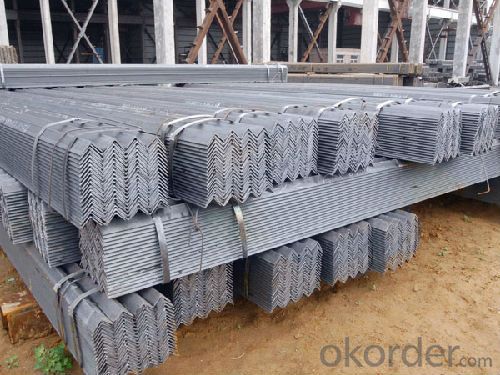
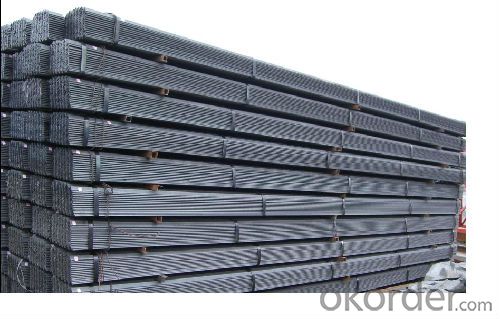
- Q: What are the common bending or forming processes used for steel angles?
- There are several common bending or forming processes used for steel angles, depending on the desired shape and specifications. One common process is roll bending, where the steel angle is passed through a series of rollers that gradually bend it into the desired curve or shape. This process is often used for larger angles and provides precise and consistent bending. Another common process is press braking, where the steel angle is placed between a punch and die and a significant amount of force is applied to bend it into the desired shape. This process is versatile and can be used for both small and large angles, allowing for various bending angles and shapes. Hot bending is another method used for steel angles, where the angle is heated to a high temperature and then bent into the desired shape using specialized equipment. This process is suitable for larger angles and allows for more complex bending shapes. Lastly, cold bending is a popular process for steel angles, where the angle is bent using force without the need for heating. This method is commonly used for smaller angles and provides a cost-effective and efficient way to achieve simple bending shapes. Overall, the choice of bending or forming process for steel angles depends on factors such as the size, thickness, and shape requirements, as well as the desired cost and production efficiency.
- Q: How do steel angles contribute to the overall torsional stiffness of a structure?
- Steel angles contribute to the overall torsional stiffness of a structure by providing resistance against torsional forces. The angled shape of the steel members helps to distribute and transfer these forces, preventing excessive twisting or rotation of the structure. This added stiffness helps to maintain structural integrity and stability, ensuring that the structure can withstand torsional loads and maintain its desired shape.
- Q: Are steel angles fire resistant?
- Steel angles are commonly regarded as fire resistant. This is because steel is a material that does not burn and can withstand high temperatures. Steel angles, which are L-shaped structural components, are widely used in construction and engineering due to their strength and durability. In the event of a fire, steel angles remain structurally intact and do not deform, which is crucial for the safety of a building or structure. However, it is important to consider that the fire resistance of steel angles may be influenced by various factors such as size, thickness, fire protection measures, and the duration and intensity of the fire. To enhance the fire resistance of steel angles and improve overall fire safety, measures like fire-resistant coatings, fire barriers, and fireproofing materials can be employed.
- Q: What are the advantages of using steel angles in manufacturing?
- There are several advantages of using steel angles in manufacturing. Firstly, steel angles provide excellent structural support and stability, making them ideal for various applications such as constructing buildings, bridges, and machinery. Secondly, steel angles have high tensile strength and durability, ensuring long-lasting and reliable performance. Additionally, steel angles are versatile and can be easily customized and fabricated to meet specific design requirements. Lastly, steel angles are cost-effective, readily available, and have a high recyclability rate, making them an environmentally-friendly choice for manufacturers.
- Q: Can steel angles be used in mining or offshore applications?
- Yes, steel angles can be used in mining or offshore applications. They are commonly used in these industries due to their high strength, durability, and corrosion resistance properties. Steel angles are versatile and can be utilized for various purposes such as structural support, framing, and bracing in mining operations or offshore structures.
- Q: Are there any industry standards or certifications for steel angles?
- Yes, there are industry standards and certifications for steel angles. The most widely recognized standard for steel angles is the American Society for Testing and Materials (ASTM) standard. The ASTM A36 specification is commonly used for structural steel angles and provides specific requirements for chemical composition, mechanical properties, and dimensional tolerances. In addition to ASTM, other organizations such as the American Institute of Steel Construction (AISC) and the Steel Joist Institute (SJI) provide guidelines and standards for steel angles used in construction and structural engineering applications. These standards ensure that steel angles meet specific requirements for quality, strength, and performance. Furthermore, certifications such as ISO 9001:2015 and ISO 14001:2015 are widely recognized in the steel industry, indicating that a manufacturer has implemented a quality management system and meets environmental management standards. It is important for manufacturers, suppliers, and construction professionals to adhere to these industry standards and certifications to ensure the reliability and safety of steel angles in various applications.
- Q: How do you calculate the bending capacity of a steel angle?
- In order to determine the bending capacity of a steel angle, several factors must be considered. The initial step involves calculating the moment of inertia (I) of the angle section, which measures its resistance to bending. The moment of inertia relies on the angle's shape and dimensions, and can be found in the manufacturer's specifications or through calculations. Once the moment of inertia has been obtained, the section modulus (Z) can be calculated as another indicator of the section's ability to resist bending. The section modulus is found by dividing the moment of inertia by the distance from the centroid of the section to the extreme fiber. Subsequently, it is necessary to establish the maximum allowable bending stress (σ) for the steel angle. This value is typically provided by the manufacturer or can be determined based on the desired safety factor and the type of steel being used. Lastly, the bending capacity (M) of the steel angle can be calculated by utilizing the formula M = σ * Z. This calculation provides the maximum moment that the angle can endure without experiencing excessive bending stress. It is important to note that these calculations assume the angle's behavior is elastic and do not account for additional factors such as local buckling, residual stresses, or combined loading. Therefore, it is advisable to consult relevant design codes or guidelines for a more comprehensive analysis to ensure the safety and reliability of the steel angle in a specific application.
- Q: How do you calculate the weight of a steel angle?
- In order to determine the weight of a steel angle, one must have knowledge of its dimensions and the density of steel. The weight of an object can be determined by using the equation: Weight = Volume × Density For a steel angle, the volume can be obtained by multiplying the cross-sectional area of the angle by its length. The cross-sectional area of the angle can be calculated by multiplying its width by its height. Once the volume is determined, it can be multiplied by the density of steel to find the weight. Let's consider an example where a steel angle has a width of 3 inches, a height of 3 inches, and a length of 6 feet. The density of steel is typically around 7850 kg/m³ or 0.2836 lb/in³. To begin, calculate the cross-sectional area: Area = width × height Area = 3 in × 3 in Area = 9 in² Next, compute the volume: Volume = Area × length Volume = 9 in² × 6 ft × 12 in/ft Volume = 648 in³ Finally, determine the weight: Weight = Volume × Density Weight = 648 in³ × 0.2836 lb/in³ Weight = 183.9828 lb Hence, the weight of the steel angle would be approximately 183.98 pounds.
- Q: How do steel angles perform in terms of durability and longevity?
- Steel angles are widely recognized for their exceptional durability and longevity. Thanks to their composition, which includes a substantial amount of iron and carbon, steel angles possess remarkable strength and resistance to various forms of wear and tear. They have the ability to withstand heavy loads, extreme temperatures, and exposure to corrosive elements, thereby making them highly durable and suitable for a wide range of applications. In terms of their longevity, steel angles boast an impressive lifespan. They are specifically engineered to endure the test of time and maintain their structural integrity over extended periods. The inherent strength and resilience of steel angles ensure that they do not easily deteriorate, thus making them a reliable choice for long-term usage. What's more, steel angles require minimal maintenance to preserve their durability and longevity. Regular inspections and cleaning can effectively prevent the accumulation of rust and other forms of corrosion, thereby ensuring that the angles remain in optimal condition throughout their lifespan. Additionally, steel angles can be galvanized or coated with protective layers to further enhance their durability and resistance against environmental factors. Galvanization involves the application of a layer of zinc to the surface of the steel, providing an additional barrier against rust and corrosion. Alternatively, the angles can be coated with epoxy or powder coatings to enhance their durability and longevity in specific environments. All in all, steel angles are renowned for their exceptional durability and longevity. They offer a reliable and long-lasting solution for a variety of structural and construction needs, which explains their popularity in numerous industries.
- Q: How do you calculate the moment of inertia of a steel angle?
- To calculate the moment of inertia of a steel angle, you can use the basic formula for moment of inertia, which is I = (1/12) * b * h^3, where I represents the moment of inertia, b is the base width of the angle, and h is the height of the angle.
Send your message to us
Equal Angle Steel High Quality Q235 or ASTM A36 20-250mm
- Loading Port:
- Tianjin
- Payment Terms:
- TT or LC
- Min Order Qty:
- 25 m.t.
- Supply Capability:
- 10000 m.t./month
OKorder Service Pledge
OKorder Financial Service
Similar products
Hot products
Hot Searches
Related keywords
